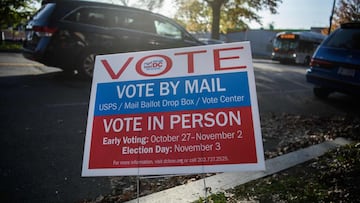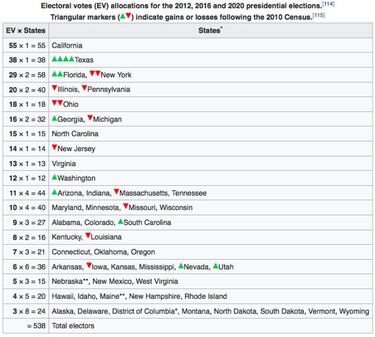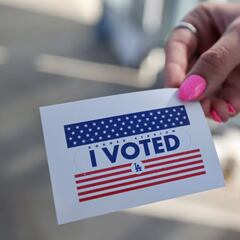US election 2020: what's the electoral college, which states have most electors?
As Donald Trump and Joe Biden vie for the US presidency on Tuesday, they know that it is electoral votes - rather than the popular vote - that will decide who wins the race for the White House.

Republican incumbent Donald Trump and Democratic challenger Joe Biden go head to head for the presidency of the United States on Tuesday, as the nation chooses its commander-in-chief for the next four years.
And to win the race for the White House, Trump and Biden know they don't necessarily need to get more votes from the American people than their opponent does.
That's because when it comes to deciding the identity of the US' next president, what really matters is how many votes each candidate obtains from what is known as the 'electoral college'.
The US electoral college: what is it?
When citizens cast their ballots in a US presidential election, they're in fact only voting for their preferred contender indirectly. What they are directly choosing are the members of a group of officials who in turn are tasked with voting in the new president in accordance with the result of the popular election in each state.
538 people go into the electoral college - a figure that represents the total number of congressmen and women in the House of Representatives (435) and Senate (100), plus the three electors allocated to the District of Columbia under the 23rd Amendment to the Constitution in 1961. Every elector counts for one electoral vote.
Each party nominates its candidates to be one of the presidential electors, usually selecting them from long-term party activists, donors or office holders.
The electoral college's votes are cast a few weeks after Election Day; this year, it is due to happen on 14 December. A presidential candidate must win half the electoral-college votes plus one to claim victory, so 270 is the number in Trump and Biden's sights.
- US elections 2020: how and where do I vote?
- Number of US early voters surpasses 2016
- US elections 2020: can people from Puerto Rico vote?
Which US states have the most electors?
The total electors that each state gets is equal to the amount of representatives it has in Congress: the number of seats it has in the House plus the two senators that every state is allocated in the upper chamber.
With 55, California has the most, followed by Texas (38), Florida and New York (both 29). At the other end of the scale, there are just three in Alaska, Delaware, the District of Columbia, Montana, North Dakota, South Dakota, Vermont and Wyoming.

The US electoral college: when and why was it created?
The electoral college was created with the US Constitution in 1787, as a compromise between members of Congress choosing a president and qualified citizens voting for their preferred choice.
According to the Brennan Center for Justice this was, in part, because the Founding Fathers were uncomfortable with giving power to the people. The system was also engineered to empower the white south in times of slavery.
Today, it is seen by many as a flawed system, going against the ‘one person, one vote’ principle of democracy and not being representative of the country.
How can the electoral college affect presidential elections?
This century alone, after all, two out of the five US presidential elections have been won by the candidate who came second in the popular vote.
In 2016, Donald Trump received nearly three million fewer votes than Hillary Clinton, but secured 77 more electors. In 2000, meanwhile, George W Bush beat Al Gore to the presidency with 271 electoral votes, despite over 500,000 more people voting for Gore.
Electoral-votes-to-population ratio can vary from state to state
How could this happen? Well, it should first be noted that the number of electors may match each state’s total members of Congress, but the ratio of House representatives per resident can vary wildly from state to state.
For example, Montana’s 1,050,493 people have just one House member but Rhode Island, a state with only 9,000 more residents, is tipped into the bracket of having two House representatives, which is one per 529,820.
Winning the popular vote in Rhode Island is therefore twice as valuable in terms of House electoral votes as it is in Montana, despite the states' almost identical populations.
Meanwhile, the fact that every state gets two senators regardless of its size allows a presidential candidate to pick up electoral-college votes in smaller states in exchange for fewer popular votes than in larger ones.
Winner-takes-all electoral-college system makes 'swing' states crucial
A further factor that can contribute to the outcomes seen in 2000 and 2016 is that all but two states operate a winner-takes-all system when handing out their electoral votes (Maine and Nebraska are the exceptions). As a result, candidates can win a state by only a fine margin in the popular vote but see that victory translate into a comparatively large one in terms of its effect on the electoral-vote count.
For example, Trump's win over Hillary Clinton four years ago was aided by tight wins in Michigan, Pennsylvania and Wisconsin.
It's for this reason that presidential contenders' campaigns usually place significant focus on coming out on top in electoral-vote-heavy 'swing' states - places like Florida, Michigan, Ohio and Pennsylvania - where the result is likely to be a close call.
Is there an alternative to the electoral-college system?
Related stories
There is an idea that’s been gaining more traction over recent years, although it would not be a simple changeover. We wrote a piece on what is known as the popular-vote system.
Election Day: live coverage
You can follow Election Day 2020 live with our dedicated rolling feed.

